Art Composition |
|||||||||||||||||||||
|
Page 06 / 14
COMPOSITIONCHAPTER VPERHAPS the most elementary and yet one of the most abstruse qualities of landscape painting is composition. The moment a painter places any arrangement of forms upon his canvas he makes a composition and at the same time encounters its difficulties. It is easy to recognise bad composition, and easy to avoid what is obviously wrong, but there is a very far cry between what is not bad and what is really distinguished. No one would think of taking Nature always just as she is ; even the photographer with his limited power takes the greatest pains in the arrangement of the material before him. The painter with fuller powers has greater responsibilities, and if there be some excuse for the former in consideration of his limitations, there is none for the latter. The problem of composition faces him. at the very outset of his work; he may be quite certain of its importance in the other arts, recognising its claims in Music, Poetry, and Architecture. He may acknowledge that Nature has offered fewer suggestions to the sister arts than to the landscape painter, but. suggestions of breadth, dignity and style, which she has offered each, are necessary to them all. 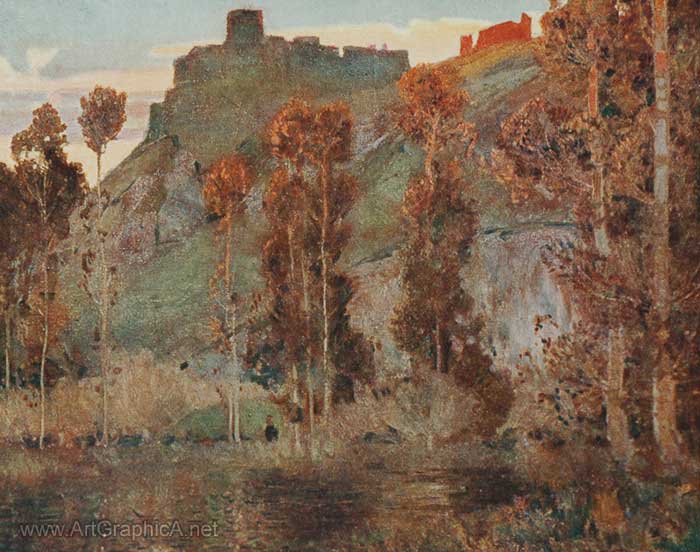 Chateau Gaillard. 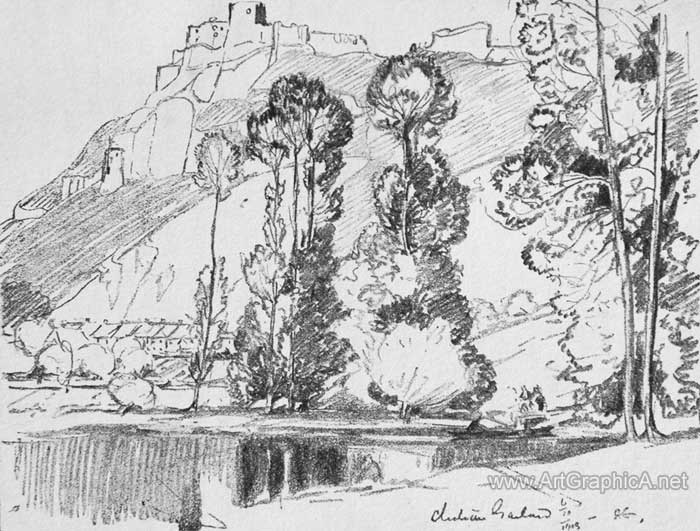 The sketch. Art composition. If the painter finds that rare thing in Nature, the happiest conjunction of the most suitable forms for a great composition, and he appreciates its worth, his appreciation is the proof that he understands what constitutes fine composition. If he cannot discern it in Nature, he cannot be expected to venture into that difficult field, wherein he assumes the authority to transpose his materials to suit his purposes, and of selecting what he requires for the definite object he may have in view. In the art of composition he accepts the whole of the responsibility of his position, for either success or failure. Since composition is an essential in the expression of art, one feels how important a few hints may be, for the landscape painter is surrounded by many pitfalls and snares, and the more he may love Nature the more difficult he may find it to avoid them. Innumerable unessential details, though attractive in themselves, may mean destruction to his composition. The authority to select is not only necessary but obvious. Therefore a painter must assume that authority to which, as a man, he has an undoubted right. Art and composition is a convention founded upon wide principles. If it is not yet demonstrated why certain arrangements of form and colour give pleasure, and other arrangements give pain, it is not a question for us, but for the scientist. 'We know that it is so, and therefore, without going into the origin of the pain or pleasure, we must accept the facts as we find them. The finest and most prominent quality is balance; the sense of balance gives one the feeling of satisfaction. There are numberless means by which this may be obtained, each governed by certain conditions. The decorative artist has his special conditions, the architect his, as also in their sphere the poet and musician have theirs. We have to consider what those conditions are which govern landscape painting. This interesting quality of balance can be demonstrated by the steelyard arm, or the illustration of the balance of a pound of lead to a pound of feathers. For example, two pounds of lead would balance bulk for bulk--such a fact is too obvious to arouse one's interest ; but the moment the bulk of the one is increased and the bulk of the other diminished, one's interest is instantly stirred, and the question arises as to what difference of material causes the change of dimension. So in the case of the steelyard, the disproportion of weight, of course, determines the placing of the pivot : if that be just, there will be a perfect balance. Now imagine your pound of feathers, large in bulk, to be the clump of trees, and your counterpoint on the other side of your picture to be your pound of lead--i.e. an object of a strong and definite value--you recognise at once where the point is in your picture upon which these quantities will swing. That point or pivot is one of the most interesting parts of your composition, because it is the blind spot ; there, and there only can be placed any accent such as a figure or figures in one's landscape which will not disturb the previously arranged composition. Frequently I have composed a landscape without the introduction of a figure, and afterwards, for the sake of scale--for everything in art must be governed by the size of the human figure--it seemed appropriate to introduce one, and I have always found that if the composition was correct, the place for the figure was in the centre of the canvas--i.e. exactly half-way between its two sides--and formed the pivot which I have already described. On the other hand, if you design a picture with the intention of introducing figures, you would not of course place them in that position at first, but would so shift the balance of the other objects in the picture, such as the trees, sky forms, etc., as to make the introduction of the figures agreeable, or in other words, to make the balance just. Now a few words of practical advice. Beware of equal quantities of light and dark. See that the masses of your dark, such as trees or houses, are not equal in form or area to your masses of light, such as water, sky, or road. See that the dark masses do not divide the picture in two equal parts. (Sec illustrations A and B.)
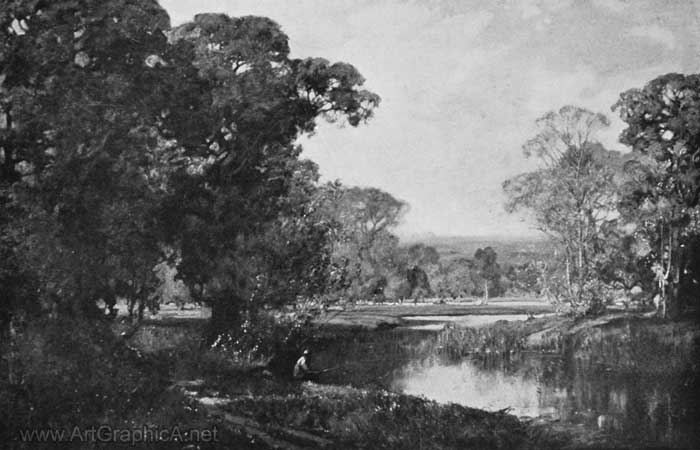 Opulent Autumn. After having made up your mind how to arrange the big masses of dark and light upon your canvas, you will begin to discern that there are other things which call for consideration. The question of tone, for instance. You will find that the tone of your masses, in relation to the tone of your sky, plays an important part in the matter. For example, it is easily understood that a small light looks more brilliant when in close contact with a deep tone than if it were surrounded by tones of the same value, although the colour might he different ; the composition, therefore, may have to be modified through the darkness or lightness of the sky, or the contours of its forms. I find it better to paint the contours of my sky forms to suit the contours of my landscape. You must always bear in mind that every contour in your composition is gauged by the right angle of your canvas and the edge of your picture, and in the relation to these lines should be the expression of the curves. These contours have au essential purpose to serve, insomuch that they must express the nature of the material. They should also be big in feeling and noble in design. I have pointed out that the curvature of any line is immediately seen by comparison to the edge of your canvas, and it will be understood that the scale of your picture will also be governed by it. For example, a number of small curves do not convey the same sense of dignity and style as large ones if they be fine. You sec that in the landscape by Rubens in the Mai Gallery. This picture conveys no sense of style; it is all frittered away by several small incidents, each attracting the eye and not helping the general effect of the whole. How different is that by Corot I There we see but one intention expressed, and the introduction of the figures adds to the value of that intention. You see in the former no sense of balance, while in the latter this feeling is so delicate that one touch more of dark or light would destroy its charm. In this illustration by Corot one sees the application of the general principle I have spoken of in the introduction to this chapter. But here let me warn the young landscape painter against the imitation of the Masters. A young man once said to me, that he was in great distress about forming a style ; that when he went out on a misty morning he thought of Corot, and if the morning were breezy he remembered Constable. I said, " Why don't you remember yourself? Aren't you a man ?" That is what I want you to remember, and I say it again, at the risk of repetition, you are to work in the spirit of the old Masters, and not in the letter. I do not want you to compose all your canvases like Corot because I point out to you one of his qualities, which stands out in contrast to the absence of that quality in Rubens. I would advise you to study the work of Claude in his " Liber Veritatis "; better still, Turner's " Liber Studiorum " (that Master who, whatever his materials were, always presented to you a noble composition). And then, if there is anything in you, you will form your own style. The study of the works of these great men will help you to a better understanding of the great importance of composition. Each had his own personal way of looking at Nature, although their modes of expression were different, but they were one in the great principles that underlay their art.  Landscape. From the Painting by Corot. I should like to encourage you to cultivate the force and personal qualities which these men possessed, and if you have sufficient knowledge you, like Turner, could transpose your materials. If you have not, do not try, for you will come to grief. The removal of a tree, or the diversion of a road, or the rearrangement of any smaller details will give you trouble, and that is a proof you do not know enough of the principles of composition. 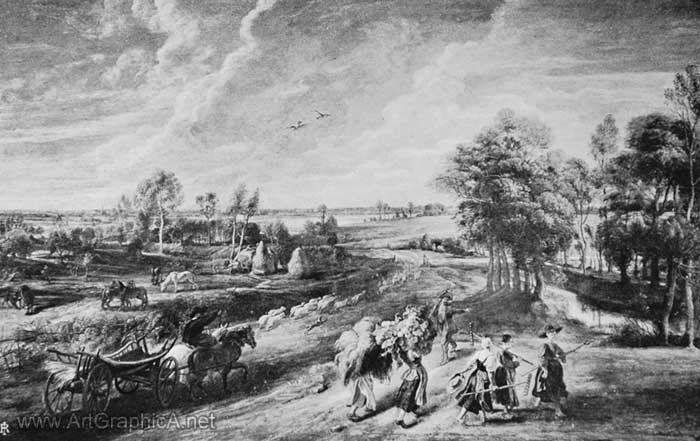 The Return from the Fields. From the painting by Rubens. One overlooks many little personal peculiarities and falsities in great work if the essentials are right, and I would impress upon you the necessity for bearing this fact in mind, that if the essentials are wrong, no matter how beautifully the details are painted, the picture cannot be a fine work of an Your business is to express big thoughts--big ideas, by big means--and it is possible to do so without the sacrifice of truth to Nature. There is no reason why you should lose the characteristics of the particular tree you are painting, because you make its contour finer, or remove it to another place. Trees differ as much in personal character as men. You will find noble forms and mean ones; they are at your option. If you paint a mean one which is not suitable to your purpose, simply because it grows in the same vicinity as the other material you are sketching, it is because you have not the power to alter it, or are too lazy to attempt it : either thing is enough to ruin your work. Let me ask you to look at Nature with wide eyes, a large appreciation, and a broad, generous, and synthetic outlook; and if you intend to express the splendour of her dignity and the breadth of her repose, you may still do more than the man who thinks a .pretty hedgerow or a moss-grown cottage all sufficient for a noble landscape. Having spoken of the larger qualities of composition, let me point out to you some minor considerations, the aggregate of which should assist you to build up a picture. You may have rhythm, but be careful lest your rhythm degenerate into repetition_ Do not let alliteration of form be obvious. alliteration is a distinctly charming quality in composition but it is a dangerous one in the hands of the ignorant look to tour angles, at they do not become too dominant. There are fewer things so that composition as a right angle, and remember that telling" in paint anything, you at the same time form the shape of something else, and in any large quantity of dark you have in a measure defined the shape of the and of other area of the the light. You may see in the work of Ruysdael, painters, and of other old Dutch painters, the most sincere effort to paint every leaf on the tree, sincerity worthy of a better cause. Notice the constant repetition of forms, and not only the repetition of the form of leaf, but what interests us more at the moment, the repetition of their branches. You may see that Claude and Poussin did this, which gave their trees an air of unreality. It was not till Turner came and explained the matter that we saw in art the " happening" of Nature. As the method of painting trees will be dealt with in a separate chapter, I shall speak only of trees as material in composition. I will only point out to you that the repetition of branch form of the same quantity and contour is to be avoided. Remember the value of the human figure in composition. A small figure will alter the balance of your composition much more than a larger surface of any inanimate object : its weight in the balance of your composition is out of all proportion to its size -- even a large tree would not upset the balance of the composition so much. A small light surrounded by darks has a much greater weight than a larger light in contact with a lighter tone, and a small dark on light has a greater effect than a larger light superimposed upon a half-tone. Each touch, either of light or dark, forms a portion of your composition, and should be essential ; for what does not really help must be a drawback. A fine design is that which the slightest alteration will spoil : an inch in a canvas of twenty-four square feet is sufficient to destroy the balance of its parts, and a good composition cannot be added to or subtracted from. It is complete. If it has given you a good deal of trouble, and necessitated your making many studies, it is worth while, for the satisfaction of feeling that it is well done.
Some of the forms of landscape composition may be described as triangular (see "Moonlight in the Cotswolds," frontispiece, and " A Berkshire Meadow,"), circular (see " Morning in the Cotswolds," " Lake Bourget from Mont Revard,"), or convergent (see " Lonely Road," and "The Aftermath,"), but one does not think to what order any composition belongs, if it be good.  Morning in the Cotswolds. Art Composition Remember that no spaces must be equal between the masses, or between the masses and the edge of the frame ; that the lines should be in harmony as well as the masses. I mean that the swing of the outline of the tree or any object should not be needlessly interrupted ; that the great mass of darks should not be placed in sudden opposition to the lights, but should be broken by half-tones. The sense of breadth and harmony is thus secured. But where you wish to produce a very strong effect, such as a storm, the hardness is modified by the dark sky. One cannot throw over all rules of composition without seeing instantly there is something wrong, and until Bear in mind your linear as well as your aerial perspective. In your composition your lines should be sympathetic, and when they are not pleasant in Nature and have a soft and sleepy feeling, the refreshment can be obtained by a dark or light, but more frequently by the addition of an opposing line which should be led up to with great discretion and care. To improve your composition your picture may require an increase of size. Such an alteration is invariably made at the top, but it is a more difficult matter to add to a canvas than to cut it down ; an addition means relining, which brings many difficulties in its train, and should be carefully considered before such a step is taken. I would almost go so far as to say that it would be better to repaint it, than resort to this. There are so many interesting problems in composition, that it would require more space than I have at my disposal to describe them--the bearing of one thing upon another, the relative influence of lights and darks, apart from the sentiment of the picture. But this may be said of the art of composition, that it is one of the most interesting, though it may be the most difficult problem for the painter.
Next Page
Prev PageWhat is Colour? Pencil Drawing from Nature
|
|||||||||||||||||||||
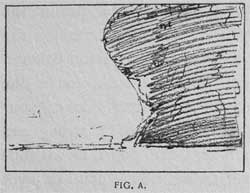
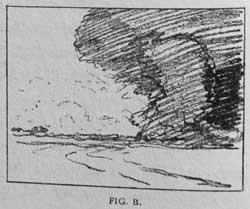 You will observe that the quantity of space covered by the trees in Fig. A is equal to that covered by the sky, and not only is there equality of quantity, but more or less equality of form. This will be better understood by turning the sketch upside down. Such faults are frequent, and should be most carefully avoided owing to the repetitions of forms in Nature; but you will see in this example what not to do. Note that the form of the sky is practically the same as the rounded forms of the trees. This danger, great as it is, is perhaps less marked than the inclination to repeat forms in Nature, such as the contours of the branches of the trees and of clouds. The branches of trees offer you an opportunity of falling into the error more easily, since it is more apparent to the casual observer. Before speaking of the smaller forms of Nature, let me urge you to be careful, before you touch your canvas with a brush, to see that your big things are right. If they are right, you may be sure the little ones will, more or less, take care of themselves. Therefore, when you have a large canvas before you, the first thing to do is to determine on the scale of the subject you wish to paint. With a piece of charcoal you roughly outline the great masses as described in another chapter, and when you have arranged the masses of your material and found the scale, you decide how much or how little of the field of vision you can include within your canvas, and this can only be done by a number of pencil drawings in your book, or a number of charcoal outlines on your canvas. You have to consider what is the object of painting the subject ; whether' it be merely to make a copy of the material before you, or so to arrange the material that it will express the emotion Nature may have given you. You may elect to paint the large masses of the trees clear of the top of the canvas, or, on the contrary, you may choose to cut off the tops by permitting them to run out of the picture. These matters arc at your discretion ; the fineness or poverty of the composition depends upon the discretion used.
You will observe that the quantity of space covered by the trees in Fig. A is equal to that covered by the sky, and not only is there equality of quantity, but more or less equality of form. This will be better understood by turning the sketch upside down. Such faults are frequent, and should be most carefully avoided owing to the repetitions of forms in Nature; but you will see in this example what not to do. Note that the form of the sky is practically the same as the rounded forms of the trees. This danger, great as it is, is perhaps less marked than the inclination to repeat forms in Nature, such as the contours of the branches of the trees and of clouds. The branches of trees offer you an opportunity of falling into the error more easily, since it is more apparent to the casual observer. Before speaking of the smaller forms of Nature, let me urge you to be careful, before you touch your canvas with a brush, to see that your big things are right. If they are right, you may be sure the little ones will, more or less, take care of themselves. Therefore, when you have a large canvas before you, the first thing to do is to determine on the scale of the subject you wish to paint. With a piece of charcoal you roughly outline the great masses as described in another chapter, and when you have arranged the masses of your material and found the scale, you decide how much or how little of the field of vision you can include within your canvas, and this can only be done by a number of pencil drawings in your book, or a number of charcoal outlines on your canvas. You have to consider what is the object of painting the subject ; whether' it be merely to make a copy of the material before you, or so to arrange the material that it will express the emotion Nature may have given you. You may elect to paint the large masses of the trees clear of the top of the canvas, or, on the contrary, you may choose to cut off the tops by permitting them to run out of the picture. These matters arc at your discretion ; the fineness or poverty of the composition depends upon the discretion used.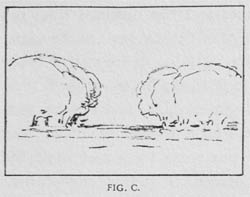
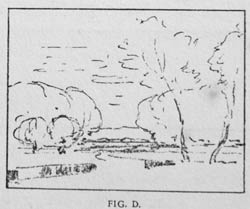 There are painters whose work depends entirely upon the colour; they ignore the quality of composition for the sake of some minor truths. Believe me, when the colour goes, as it must in the course of years, there will be nothing left to speak of its excellence ; if there is no beauty of design, then the value of the picture as a work of art will be lost. Composition is one of the greatest qualities in art, it makes all the difference between a fine work and a mean one. I will attempt by means of a few illustrations to convey more clearly what I mean.
There are painters whose work depends entirely upon the colour; they ignore the quality of composition for the sake of some minor truths. Believe me, when the colour goes, as it must in the course of years, there will be nothing left to speak of its excellence ; if there is no beauty of design, then the value of the picture as a work of art will be lost. Composition is one of the greatest qualities in art, it makes all the difference between a fine work and a mean one. I will attempt by means of a few illustrations to convey more clearly what I mean.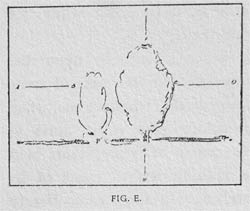 Fig. C will convey no sense of composition ; but the moment you place other forms across one of the masses in the form of tree trunks and clothe them with foliage, you produce an effect as in Fig. D, which is not unpleasant ; but you see you must introduce other forms to balance this addition, so you may feel your way to what is right. Then with the correction of line, and the addition of clouds, you have a balance which we call composition. Examples might be repeated constantly. One may suffice (see Fig. E), which is the reverse of the example above; in this the objects are not at each side, but in the centre of the canvas. This, as you see, is important, as the distances from A to B and C to D are equal, and the distances from E to 1-; and G to H are equal.
Fig. C will convey no sense of composition ; but the moment you place other forms across one of the masses in the form of tree trunks and clothe them with foliage, you produce an effect as in Fig. D, which is not unpleasant ; but you see you must introduce other forms to balance this addition, so you may feel your way to what is right. Then with the correction of line, and the addition of clouds, you have a balance which we call composition. Examples might be repeated constantly. One may suffice (see Fig. E), which is the reverse of the example above; in this the objects are not at each side, but in the centre of the canvas. This, as you see, is important, as the distances from A to B and C to D are equal, and the distances from E to 1-; and G to H are equal. 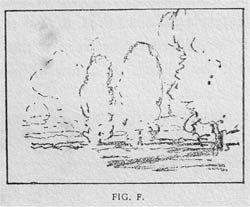
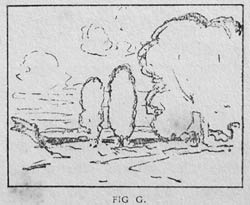 This is not right. The bulk of the trees and the distance from the edge of the canvas are the same. You may say to yourself, " What am I to do in this case ? Can I put a dark sky in one side and light in the other, or can I put some trees and show the distance in the other--which would be the better ? " You make the experiment, with this result (see Fig. F), and may paint a large tree to the right or left of your picture which destroys the sense of equal distribution. The painter can raise or lower this or that as he feels his picture requires it (see Figs. G and H) ; and when he has done this, he might take his mirror, and see what that most impartial friend says of his design ; if it still holds good reversed, I think he may be satisfied that it is correct.
This is not right. The bulk of the trees and the distance from the edge of the canvas are the same. You may say to yourself, " What am I to do in this case ? Can I put a dark sky in one side and light in the other, or can I put some trees and show the distance in the other--which would be the better ? " You make the experiment, with this result (see Fig. F), and may paint a large tree to the right or left of your picture which destroys the sense of equal distribution. The painter can raise or lower this or that as he feels his picture requires it (see Figs. G and H) ; and when he has done this, he might take his mirror, and see what that most impartial friend says of his design ; if it still holds good reversed, I think he may be satisfied that it is correct.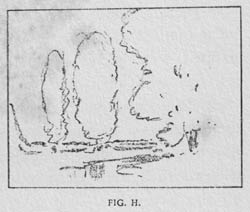 you can detect such errors, you cannot hope to make a noble design. You must also think of the quality of your material before you think of its disposition : thus elms and oaks have a different effect to black poplars, the first strong, the latter soft.
you can detect such errors, you cannot hope to make a noble design. You must also think of the quality of your material before you think of its disposition : thus elms and oaks have a different effect to black poplars, the first strong, the latter soft.







